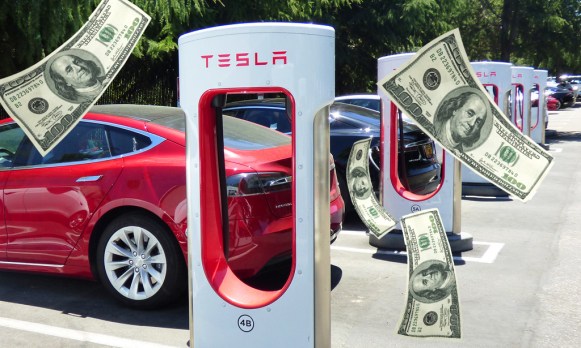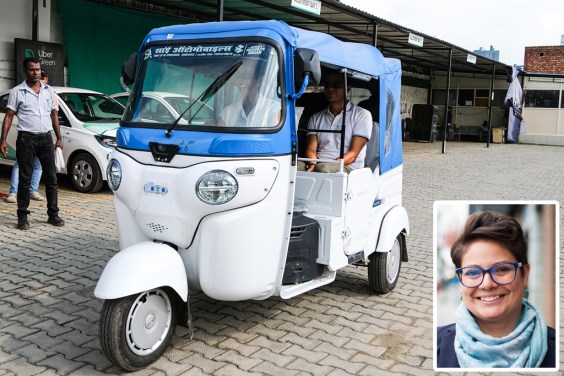
The richest 30 percent of New York State residents have gotten more than 62 percent of all electric car rebate checks while the bottom 50 percent of state earners collected just 21 percent of the benefits — evidence that a state program to encourage the purchase of expensive electric cars is helping the wealthy far more than the poor.
And in some of the richest New York City ZIP codes, scores of people got the rebates, while in at least one of the poorest neighborhoods, just a single resident took advantage of the subsidy, which ranges from $500 to $2,000, depending on how many miles the vehicle can go entirely on electric power and the cost of the car itself (vehicles above $60,000, such as the Tesla Model S, qualify for the minimum $500 rebate, even though its “all-electric” range is among the highest, but the $40,000 Tesla Model Y qualifies for the full $2,000 rebate).
In New York City, the distribution of state rebates is slightly more equitable, with the top 40 percent of wage earners getting 53 percent of the rebate money. But the top 20 percent of wage earners still received 25 percent of the rebates while the bottom 20 percent received 9 percent.
Since March, 2017, the “Drive Clean” rebate program has doled out $54 million to 36,800 people across the state, an average rebate of $1,467. Here’s how the distribution of the funds breaks down geographically in New York City:
( function() {
var func = function() {
var iframe = document.getElementById('wpcom-iframe-bf5aa255b7a5f18bd5b201847b63665c')
if ( iframe ) {
iframe.onload = function() {
iframe.contentWindow.postMessage( {
'msg_type': 'poll_size',
'frame_id': 'wpcom-iframe-bf5aa255b7a5f18bd5b201847b63665c'
}, "https://embeds.streetsblog.org" );
}
}
// Autosize iframe
var funcSizeResponse = function( e ) {
var origin = document.createElement( 'a' );
origin.href = e.origin;
// Verify message origin
if ( 'embeds.streetsblog.org' !== origin.host )
return;
// Verify message is in a format we expect
if ( 'object' !== typeof e.data || undefined === e.data.msg_type )
return;
switch ( e.data.msg_type ) {
case 'poll_size:response':
var iframe = document.getElementById( e.data._request.frame_id );
if ( iframe && '' === iframe.width )
iframe.width = '100%';
if ( iframe && '' === iframe.height )
iframe.height = parseInt( e.data.height );
return;
default:
return;
}
}
if ( 'function' === typeof window.addEventListener ) {
window.addEventListener( 'message', funcSizeResponse, false );
} else if ( 'function' === typeof window.attachEvent ) {
window.attachEvent( 'onmessage', funcSizeResponse );
}
}
if (document.readyState === 'complete') { func.apply(); /* compat for infinite scroll */ }
else if ( document.addEventListener ) { document.addEventListener( 'DOMContentLoaded', func, false ); }
else if ( document.attachEvent ) { document.attachEvent( 'onreadystatechange', func ); }
} )();
Graphics by Kira McDonald
Here’s the distribution of the funds when viewed by the incomes of the New York State recipients:
( function() {
var func = function() {
var iframe = document.getElementById('wpcom-iframe-aa4151c186daa76ba2b61d7a92062905')
if ( iframe ) {
iframe.onload = function() {
iframe.contentWindow.postMessage( {
'msg_type': 'poll_size',
'frame_id': 'wpcom-iframe-aa4151c186daa76ba2b61d7a92062905'
}, "https://embeds.streetsblog.org" );
}
}
// Autosize iframe
var funcSizeResponse = function( e ) {
var origin = document.createElement( 'a' );
origin.href = e.origin;
// Verify message origin
if ( 'embeds.streetsblog.org' !== origin.host )
return;
// Verify message is in a format we expect
if ( 'object' !== typeof e.data || undefined === e.data.msg_type )
return;
switch ( e.data.msg_type ) {
case 'poll_size:response':
var iframe = document.getElementById( e.data._request.frame_id );
if ( iframe && '' === iframe.width )
iframe.width = '100%';
if ( iframe && '' === iframe.height )
iframe.height = parseInt( e.data.height );
return;
default:
return;
}
}
if ( 'function' === typeof window.addEventListener ) {
window.addEventListener( 'message', funcSizeResponse, false );
} else if ( 'function' === typeof window.attachEvent ) {
window.attachEvent( 'onmessage', funcSizeResponse );
}
}
if (document.readyState === 'complete') { func.apply(); /* compat for infinite scroll */ }
else if ( document.addEventListener ) { document.addEventListener( 'DOMContentLoaded', func, false ); }
else if ( document.attachEvent ) { document.attachEvent( 'onreadystatechange', func ); }
} )();
Streetsblog’s analysis follows a similar finding by our sister site, Streetsblog Mass, which discovered that 79 percent of the Bay State’s “MOR-EV” program rebates went to car buyers in ZIP codes where the median household income exceeds the statewide median income. And only 9 percent of the program’s subsidies went to lower-income ZIP codes, where median household income was less than 80 percent of the statewide median income. (The federal government also gives up to $7,500 to e-car purchasers — but that tax credit is scaled to a person’s tax liability, meaning low-income taxpayers may not qualify for the full rebate.)
In New York City, the map of the e-car rebates looks similar to the map of income levels. The Upper West Side’s 10023 ZIP code, with its median income of $135,000, is home to 91 rebate recipients (average rebate $1,518). The wealthy 11201 ZIP code of Brooklyn Heights (median income $129,000) had 126 rebate recipients for an average rebate of $1,473.
Meanwhile, the 10474 ZIP code of Hunts Point in The Bronx, where the median income is just $23,000, registered just two rebates, averaging $1,250 apiece.
The program certainly encourages the purchase of electric cars — but it may be encouraging more car ownership overall, given that a large portion of rebates are being collected in neighborhoods with traditionally low car ownership.
For instance, according to census data, in the wealthy section of Brooklyn Heights mentioned above, only 6 percent of the residents drive themselves to work every day — far less than the citywide 22 percent. But 36 percent of the households now have access to a car.
The disparity between the rich and the poor when it comes to electric car rebates may simply be baked into the system: the wealthy tend to be early adapters of tech and, being wealthy, can afford expensive cars.
A study last year that looked at a similar, though years-older, EV subsidy in California concluded that rebates “have been predominantly given to high income electric vehicle buyers.”
But the study suggested a way forward: “The share of rebates distributed to low-income groups and disadvantaged communities increased over time and after an income-cap policy was put into effect.”
New York State does not have an income cap in its program — which is run by the New York State Energy Research and Development Authority (better known as NYSERDA). Yet NYSERDA did seem to be aware that the rebates could become a benefit for the wealthy, and intentionally reduced the amount rebate on a sliding scale with the cost of the vehicle.
“The intent of the Drive Clean Rebate is to be as effective as possible at influencing consumers’ decisions,” the agency says on its website. “Research shows that on average, rebates are more effective at shifting purchasing/leasing decisions about cars with prices lower than $60,000.”
And last year, Gov. Cuomo appeared to acknowledge some of the disparity in the distribution of e-car rebates, announcing a new $25 million program — the Clean Personal Mobility Prize — that will solicit “innovative and high impact approaches that enable access to clean transportation services for disadvantaged and underserved communities.” (It’s unclear what that program is — it may be about e-scooters — and the deadline to register has been pushed back to August and the grants reduced to $21 million.)
Experts are extremely dubious about whether the current slow buildup of electric cars is going to do enough to reduce the massive carbon footprint of the transportation sector anyway. Writing in The Conversation last week, transportation professor Christian Brand pointed out that “focusing solely on electric vehicles is slowing down the race to zero emissions … because electric cars aren’t truly zero-carbon — mining the raw materials for their batteries [as the Carbon Tax Center has pointed out], manufacturing them and generating the electricity they run on produces emissions.” He recommended more bikes.
That subject is particularly troubling to Assembly Member Bobby Carroll, who has long been calling on his Albany colleagues to include e-bikes in the NYSERDA electric car subsidy, to no avail. Meanwhile, France is about to start paying people to trade in their old cars for electric bikes.
And subsidizing electric car purchases that wealthy people might make anyway runs the risk of greenwashing the dangers of electric cars. As Charles Komanoff pointed out in these pages earlier this year, subsidizing electric cars is likely to increase traffic, which could lead to more pollution.






